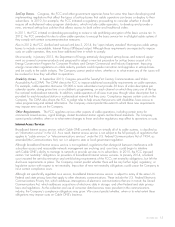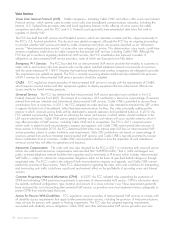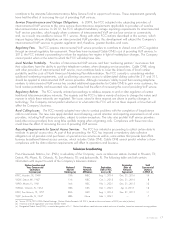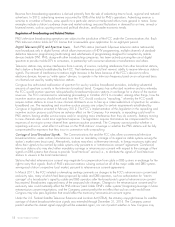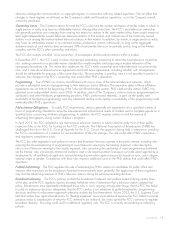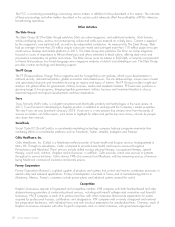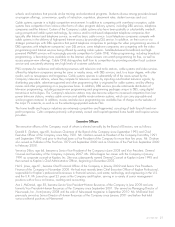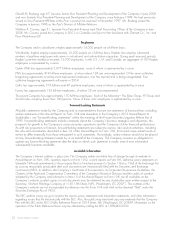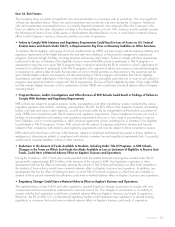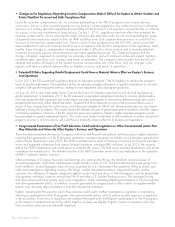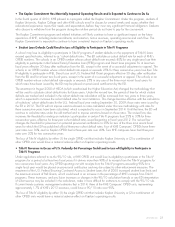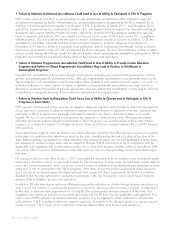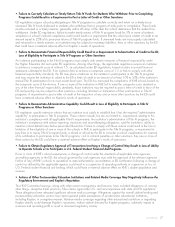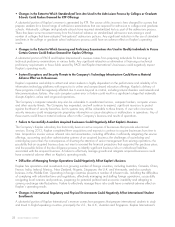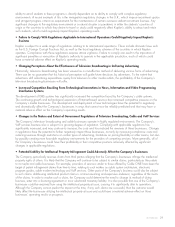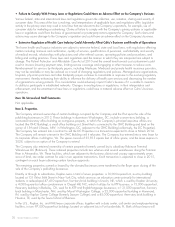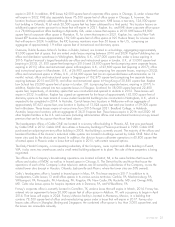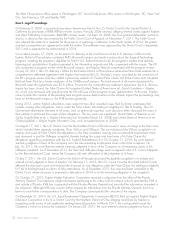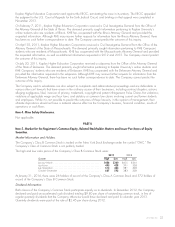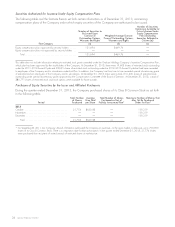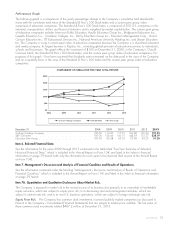Washington Post 2013 Annual Report Download - page 43
Download and view the complete annual report
Please find page 43 of the 2013 Washington Post annual report below. You can navigate through the pages in the report by either clicking on the pages listed below, or by using the keyword search tool below to find specific information within the annual report.• The Kaplan Commitment Has Materially Impacted Operating Results and Is Expected to Continue to Do So
In the fourth quarter of 2010, KHE phased in a program called the Kaplan Commitment. Under this program, students of
Kaplan University, Kaplan College and other KHE schools enroll in classes for several weeks and assess whether their
educational experience meets their needs and expectations before they incur any significant financial obligation. Students
who choose to withdraw from the program during the risk-free period do not have to pay for the coursework.
The Kaplan Commitment program and related initiatives will likely continue to have a significant impact on the future
operations of KHE, including student enrollments and retention, tuition revenues, operating income and cash flow. The
Kaplan Commitment is expected to continue to have a material impact on Kaplan’s operating results.
• Student Loan Defaults Could Result in Loss of Eligibility to Participate in Title IV Programs
A school may lose its eligibility to participate in Title IV programs if student defaults on the repayment of Title IV loans
exceed specified rates, referred to as “cohort default rates.” The ED calculates a cohort default rate for each of KHE’s
OPEID numbers. The schools in an OPEID number whose cohort default rate exceeds 40% for any single year lose their
eligibility to participate in the Federal Family Education Loan (FFEL) program and Direct Loan programs for at least two
fiscal years effective 30 days after notification from the ED, except in the event of a successful adjustment or appeal. The
schools in an OPEID number whose cohort default rate equals or exceeds 25% for three consecutive years lose their Title
IV eligibility to participate in FFEL, Direct Loan and U.S. Federal Pell Grant programs effective 30 days after notification
from the ED and for at least two fiscal years, except in the event of a successful adjustment or appeal. The schools in an
OPEID number whose cohort default rate equals or exceeds 25% in any one of the three most recent fiscal years for
which rates have been issued by the ED may be placed on provisional certification by the ED.
The enactment in August 2008 of HEOA (which reauthorized the Higher Education Act) changed the methodology that
will be used to calculate cohort default rates for future years. Under the revised law, the period of time for which student
defaults are tracked and included in the cohort default rate calculation will be increased from two years to three years,
which is expected to increase the cohort default rates for most institutions. This change became effective with the calculation
of institutions’ cohort default rates for the U.S. Federal fiscal year ending September 30, 2009; those rates were issued by
the ED in 2012. The ED will not impose sanctions based on rates calculated under this new methodology until rates for
three consecutive years have been calculated, which is expected to occur in September 2014. Until that time, the ED will
continue to calculate rates under the old method and to impose sanctions based on those rates. The revised law also
increases the threshold for ending an institution’s participation in certain Title IV programs from 25% to 30% for three
consecutive years, effective for three-year cohort default rates issued beginning in fiscal year 2012. The revised law
changes the threshold for placement on potential provisional certification to 30% for two of the three most recent fiscal
years for which the ED has published official three-year cohort default rates. Four of KHE Campuses’ OPEIDs have three-
year rates over 30%, and no Kaplan OPEID had a three-year rate over 40%. Two KHE campuses have had three-year
rates over 30% for two consecutive years.
The loss of Title IV eligibility by either (1) the single OPEID unit that includes Kaplan University or (2) a combination of
other OPEID units would have a material adverse effect on Kaplan’s operating results.
• Title IV Revenues in Excess of U.S. Federally-Set Percentage Could Lead to Loss of Eligibility to Participate in
Title IV Programs
Under regulations referred to as the 90/10 rule, a KHE OPEID unit would lose its eligibility to participate in the Title IV
programs for a period of at least two fiscal years if it derives more than 90% of its receipts from the Title IV programs for
two consecutive fiscal years. Any OPEID reporting unit with receipts from the Title IV programs exceeding 90% for a
single fiscal year would be placed on provisional certification and may be subject to other enforcement measures. The
enactment of the U.S. Federal Ensuring Continued Access to Student Loans Act of 2008 increased student loan limits and
the maximum amount of Pell Grants, which could result in an increase in the percentage of KHE’s receipts from Title IV
programs. These increases, and any future increases or changes in the 90/10 calculation formula or any ED interpretation
of what revenue may be included in the calculation, make it more difficult for institutions to comply with the 90/10 rule.
If current trends continue, management estimates that in 2014, three of the KHE Campuses’ OPEID units, representing
approximately 1.7% of KHE’s 2013 revenues, could have a 90/10 ratio over 90%.
The loss of Title IV eligibility by either (1) the single OPEID unit that includes Kaplan University or (2) a combination of
other OPEID units would have a material adverse effect on Kaplan’s operating results.
2013 FORM 10-K 25


